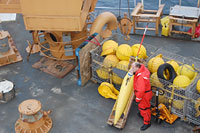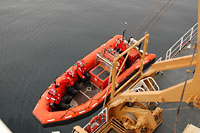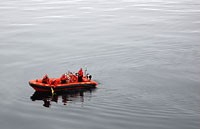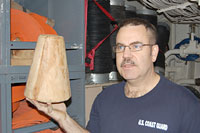

 | |||||||||||||||||
|
|
Journals 2009/2010Jonathan Pazol
September 13, 2009 Way back on August 8th - our first full day of this cruise, Commander William Sommer of the US Navy launched a sea glider from the Healy. The sea glider is a 2.8 meter (about 9 feet) long, 30 centimeter (1 foot) diameter, 110 pound instrument with wings that the Navy has developed to collect marine data. It contains a lithium battery and has a 4000 kilometer (2400 mile) range. What is amazing is that it relies on changes in density and buoyancy to propel itself forward, resulting in very low energy usage.
For the past 6 weeks, the glider has traveled at about .6 knots (.9 miles) per hour. It dives down to a depth of about 1000 meters (.6 miles) before returning to the surface about 10 hours later. When it is underwater, it acts as a CTD (Conductivity, Temperature, Depth) recorder. It also contains optical (visual) sensors and acoustic (sound) measuring apparatus to record ambient noise. The glider can record temperatures from -5° - 35° C and can also calculate depth averaged currents. When it surfaces, it sends data through an Iridium satellite back to the Naval Oceanographic Office in Stennis, Mississippi. Today, Commander Sommer and a team from the Healy recovered the glider. A signal was sent to the instrument to bring it to the surface. Then the crew took a RHIB (Rigid Hull Inflatable Boat) to recover it from the water.
The operation seemed to run flawlessly. Today's earlier fog had lifted, and the sea was as smooth as glass. The glider surfaced close to the ship at the desired location, and the crew navigated the RHIB and attached a harness around it.
Once the harness was securely in place, MSTs (Marine Science Technicians) used the winch and a-frame to bring the instrument back onto the bow. Then the glider was placed in its crate and prepared for shipment back home.
This entire operation was pretty amazing. 6 weeks ago, a relatively small instrument was lowered into the Arctic Ocean. It maneuvered around with minimal guidance and sent a very regular stream of data back to land. The glider was then instructed to surface at a designated location and was then readily brought back aboard, as planned - very cool. In previous entries I showed how Healy crew members might "batten down the hatches" during a flooding situation, and in yesterday's entry, I mentioned actual flooding in one of the compartments. If you've ever wondered where the expression, "put a cork in it" comes from, the picture below provides a very good idea. Should a pipe rupture or something penetrate the hull, crewmembers have a variety of planks, wooden wedges, and even corks/plugs at their disposal to seal the opening.
|
||||||||||||||||




